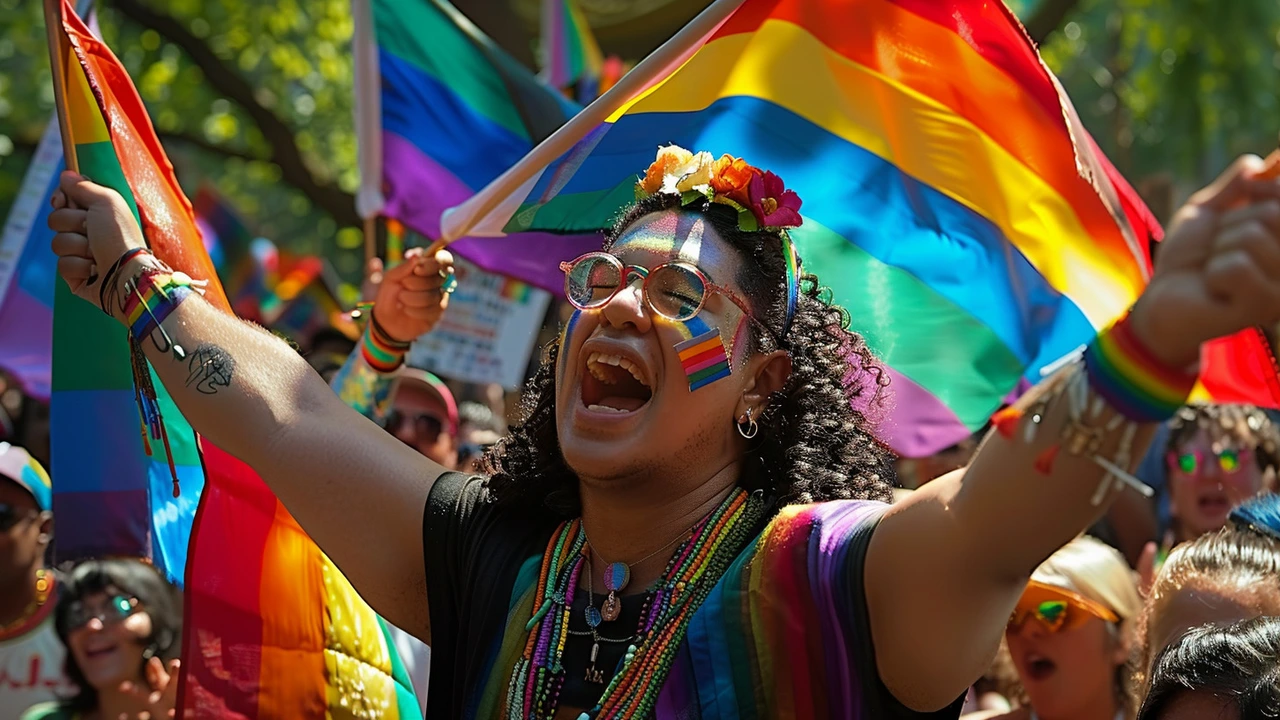A Month of Pride and Protest: The Essence of LGBTQ Pride Month
Every June, communities across the globe come alive with vibrant parades, meaningful protests, and a myriad of celebrations marking LGBTQ Pride Month. It is a time that both commemorates the rich history and significant strides of the lesbian, gay, bisexual, transgender, and queer community, and hardly anyone can deny its dual nature—it is as much a celebration as it is a stirring call to action.
The Historical Roots: The 1969 Stonewall Uprising
The origins of LGBTQ Pride Month are deeply rooted in the Stonewall uprising, a pivotal event that occurred in the early hours of June 28, 1969, in New York City's Greenwich Village. The Stonewall Inn, a popular gay bar, was raided by police, which was not an uncommon occurrence at the time. However, that night, patrons and the local community fought back, sparking a multiday series of riots that are now regarded as the watershed moment for the modern LGBTQ rights movement. This event galvanized activists and led to the formation of numerous LGBTQ rights organizations.
The First Pride March: Commemorating Stonewall
Exactly one year after the Stonewall uprising, on June 28, 1970, the first Pride marches were held in cities like New York, Los Angeles, and Chicago. These marches were organized to commemorate the resistance shown during the Stonewall riots and to demand equal rights and acceptance for LGBTQ individuals. These inaugural Pride events set the stage for what would become an enduring annual tradition, celebrated not only across the United States but around the world.
A Name of Importance: The Birth of 'Pride Month'
While the concept of Pride celebrations quickly gained momentum, it wasn't until 1972 that the term 'Pride Month' was first coined. Gay activist Byrna Aronson is credited with embedding the term in the public consciousness through an article highlighting the importance of a dedicated period to celebrate and acknowledge LGBTQ identities and issues. Since then, June has been synonymous with Pride, growing in scope and significance each passing year.
Symbols of Pride: The Rainbow Flag
A pivotal symbol within the LGBTQ community is the rainbow Pride flag, designed by artist and activist Gilbert Baker in 1978. Each color of the flag represents different aspects of the human experience—red for life, orange for healing, yellow for sunlight, green for nature, blue for harmony, and violet for spirit. More than just a flag, it stands as an emblem of diversity, unity, and the ongoing struggle for human rights. It has gained global recognition and is a staple in Pride parades and events worldwide.
Government Acknowledgment and the Role of Key Figures
On the political front, LGBTQ Pride Month received official recognition from the U.S. government for the first time in June 1999. President Bill Clinton declared it Gay and Lesbian Pride Month, a significant milestone in the journey toward equality. This recognition was later expanded by President Barack Obama, who, in 2009, declared June LGBT Pride Month. In 2016, Obama further cemented the importance of the Stonewall uprising by designating the Stonewall Inn and the surrounding area as a national monument, acknowledging its historical significance.
Global Celebrations
New York City remains a central hub for Pride celebrations, with its annual Pride March attracting millions of attendees from around the globe. São Paulo, Brazil, hosts one of the largest Pride parades, symbolizing the international resonance of Pride Month. Cities across Europe, Asia, and Africa also join in, demonstrating a broad spectrum of cultural expressions and solidarity. These gatherings are not just a testament to the progress made but also a reminder of the ongoing struggles for equality and acceptance faced by LGBTQ individuals worldwide.
A Time for Reflection and Action
While LGBTQ Pride Month is undoubtedly a time of joyous celebration, it also serves as a critical period for reflection and activism. The festivities and parades present an opportunity to spotlight ongoing issues such as discrimination, violence, and lack of legal rights that many LGBTQ individuals still face. Advocacy groups use this time to raise awareness, push for legislative changes, and challenge societal norms. The collective energy of Pride Month underscores the importance of continuing the fight for a world where everyone, regardless of their sexual orientation or gender identity, can live freely and openly without fear of persecution.
In conclusion, LGBTQ Pride Month is a profound blend of commemoration, celebration, and protest. Its roots in the Stonewall uprising serve as a reminder of the struggles faced and the resilience shown by the LGBTQ community. From the first Pride marches in 1970 to the global celebrations today, Pride Month continues to be a powerful force for change, advocating for acceptance, equality, and human rights for all.







John Smith
Stonewall wasn't just a drunken bar brawl; it sparked the first organized resistance that forced the country to reckon with queer rights. The night the police rolled in, the patrons didn't just hide-they pushed back, and that raw anger galvanized a whole generation. It set the tone for what later became the Pride parades we see today. And those early marches in 1970 were basically a street‑level call to arms, demanding visibility and equality. The movement grew from that spark, branching into dozens of organizations that still fight for us. So when you see rainbows everywhere in June, remember it started with a handful of brave folks refusing to be silenced.
Alex Soete
Yo, that energy from the 70s still fuels the vibes we have now-let's keep that momentum rolling! Every parade, every flag, every shouted chant is a reminder that we can still push for more rights. Keep the love flowing, keep the voices loud, and never forget the roots that gave us this strength.
Stay proud, stay loud, stay united!
Cara McKinzie
Honestly this whole thing feels sooo overhyped.
Joseph Conlon
While the narrative glorifies Stonewall as the singular spark, history is rarely that tidy. The riots were indeed a catalyst, but they were also part of a larger tapestry of queer resistance that spanned continents and decades. Activists in London, Berlin, and San Francisco were already challenging norms, albeit in less visible ways. Moreover, focusing solely on a single night can erase the contributions of trans and non‑binary individuals who were present yet often omitted from mainstream retellings. The flag's rainbow colors, while iconic, gloss over the deeper symbolism each hue carries for different sub‑communities. Government recognitions in the late 90s, though noteworthy, came after a long series of grassroots battles that demanded legal reforms. Funding disparities still persist, with many local LGBTQ centers operating on shoestring budgets. Legal protections fluctuate dramatically from state to state, showing that progress is uneven. Intersectional issues-like the disproportionate violence against trans women of color-remain alarmingly high. Pride marches, vibrant as they are, sometimes become corporate spectacles that dilute the original protest spirit. Yet even within that commercialization, marginalized voices continue to carve out space for authentic expression. The global reach of Pride has sparked dialogues in places where queer identities were once criminalized. Still, in many regions, activism is met with harsh crackdowns, underscoring the fragility of hard‑won gains. It's crucial to recognize that the fight for equality is a marathon, not a sprint, and that each milestone builds upon countless unsung efforts. So, honoring Stonewall means also honoring the countless unnamed heroes who fought quietly, day after day. Only by acknowledging that complexity can we truly advance the cause.
Mohit Singh
Listen, I get that some people want to romanticize the past, but let's not pretend every corner of the world has embraced Pride with open arms. In many places, even waving a tiny rainbow can land you in serious trouble. So while we celebrate here, we can't ignore the reality that oppression is still very real for countless folks. It's not just about parades; it's about real safety, legal protection, and daily respect. And yes, we should be proud, but let's also stay angry enough to keep demanding real change.
Damian Liszkiewicz
🌈 Absolutely love how the rainbow flag brings us together, each color a reminder of our shared humanity. 🏳️🌈 It's amazing seeing communities worldwide unite under this banner. 🎉 Remember, Pride is both celebration and protest-let's keep the spirit alive! ✊
Angela Arribas
Just a quick note: "Celebrating" should be spelled with two L's, not one. Also, "it's" is a contraction for it is, not its possessive. :)
Sienna Ficken
Oh, look at us, waving rainbows like it’s a fashion show. How original-another parade, another Instagram post. Don't get me wrong, kudos to the activists, but if we’re not challenging the status quo, what’s the point of all that sparkle?
Zac Death
From my chill corner, I see the parade lights and think about how far we've come and how far we still have to go. It's a beautiful tapestry of stories, each thread adding depth. While the music blasts and crowds cheer, there's a quiet undercurrent of resilience that never fades. I appreciate everyone who shows up, not just for the spectacle but for the solidarity. This vibe reminds us that community is our greatest strength, especially when the world throws shade. Let’s keep the conversation alive beyond June, because pride isn’t a month-it’s a movement.
Lizzie Fournier
Hey all, I just wanted to say how inspiring it is to see so many different cultures come together under the Pride banner. Every flag, every chant adds a unique flavor, and it's that diversity that makes the celebration truly powerful.
JAN SAE
Keep the love going, friends, and remember, each tiny step, each loud cheer, each heartfelt story, builds a brighter future, for everyone, everywhere.
Steve Dunkerley
From a policy standpoint, the advancements in anti‑discrimination statutes have been significant, yet enforcement remains uneven across jurisdictions. Continuous advocacy is essential to bridge these gaps and ensure inclusive compliance.
Jasmine Hinds
We gotta keep this energy high and push for more rights! 🎉💪
Madison Neal
I'm really grateful for all the folks who keep the conversation going, especially when we bring in research and data to back up our calls for equity. It's important we stay supportive and evidence‑based.
John Crulz
Just wondering how we can translate these historic milestones into actionable steps for younger queer folks today? Any thoughts on mentorship program ideas would be cool.
Anita Drake
Celebrating Pride is a beautiful reminder that cultures worldwide can intertwine, creating a vibrant mosaic of acceptance and love. Let’s keep honoring this shared journey.